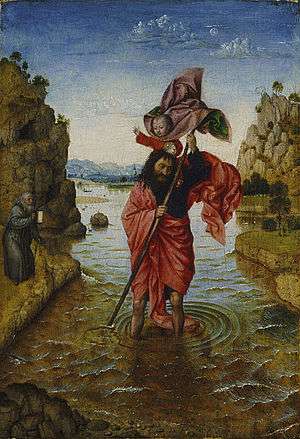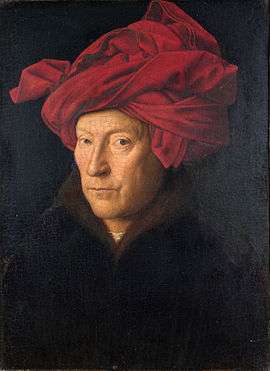Saint Christopher (after van Eyck)
Saint Christopher is a lost painting by Jan van Eyck. The painting is mainly recorded through a c 1460-70 copy on oil on oak panel, in the Philadelphia Museum of Art since 1917, and a c 1480 drawing at the Musee du Louvre. The c 1460-70 copy is by an unknown follower. Each show a giant, bearded man, wading through water with a large stick, carrying the infant Christ on his shoulders. The implication is that St. Christopher, patron saint of travelers, carries the weight of the world on his back;[1] The works show him leaning on a large stick as Christ holds a globe, with arms raised in blessing, his robe billowing to the right. The pair are set in a highly detailed, richly coloured and atmospheric landscape. There are jagged rocks on either side, set against an early evening sky, with star formations.[2]
_Louvre.jpg)

The painting was hugely influential and widely copied. It is directly referenced in a wing of Dieric Bouts Munich Adoration of the Maji, and Hans Memling's Moreel Triptych.[2]
The Philadelphia copy, through dendrochronological analysis, is placed as around 1460, and probably closely follows the colourisation of the original. However it omits a lot of detail found in the drawing, which is considered superior.
Notes
- "Saint Christopher". Philadelphia Museum of Art. Retrieved 15 December 2014
- Borchert, 156
Sources
- Borchert, Till-Holger. Van Eyck to Durer: The Influence of Early Netherlandish painting on European Art, 1430–1530. London: Thames & Hudson, 2011. ISBN 978-0-500-23883-7
